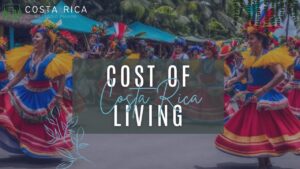What is it like to live in Costa Rica? Let’s discover Climate, Culture and Population
Costa Rica, located on the Central American isthmus, is renowned not only for its extraordinary biodiversity and breathtaking landscapes, but also for the quality of life it offers its inhabitants. Living in Costa Rica means embracing a vibrant and welcoming culture, enjoying a diverse tropical climate and experiencing a relaxed, environmentally friendly lifestyle. In this article, we will explore in detail what life is like in Costa Rica, analyzing the climate, culture and population.
Let’s discover together the beauty and diversity of life in Costa Rica! In this video we explore the tropical climate that characterizes this beautiful nation, with its seasons and meteorological peculiarities that influence the landscape and the lifestyle of its inhabitants. We immerse ourselves in the rich Costa Rican culture, with its vibrant traditions, engaging music and delicious culinary delights. Additionally, we take a closer look at Costa Rica’s multicultural population, uncovering its origins, demographic makeup, and openness to welcoming visitors from around the world. An exciting journey through the nuances that make life in Costa Rica unique!
Climate: Tropical variety
Costa Rica’s climate is primarily tropical, but varies greatly depending on region and altitude. This makes the country an ideal place for those who love the sun and warm temperatures, but also for those who prefer cooler climates.
- Coasts and Low Lands: The coastal regions, both of the Pacific and the Caribbean, enjoy a warm tropical climate all year round, with temperatures ranging between 25°C and 35°C. The dry season runs from December to April, while the rainy season lasts from May to November, with abundant but generally short and intense rainfall.
- Central Highlands: The mountainous areas and the central plateau, where cities such as San José, the capital, are located, have a more temperate climate. Average temperatures vary between 15°C and 25°C, making these areas pleasantly cooler than the coasts.
- Microclimates: Thanks to its varied topography, Costa Rica also offers particular microclimates, such as the cool regions of Monteverde, famous for its cloud forests, or the dry areas of the Nicoya Peninsula.
Culture: Pura Vida and Traditions
Costa Rican culture is a fascinating mix of indigenous, Spanish and Afro-Caribbean influences, characterized by a strong sense of community and a relaxed approach to life, summed up in the expression “Pura Vida” (pure life). This phrase, used in multiple contexts, represents a greeting, a farewell, a thank you and a way of life.
- Gastronomy: Costa Rican cuisine is simple but delicious, based on fresh, local ingredients. Typical dishes such as gallo pinto (rice and black beans), casado (complete dish with rice, beans, meat, salad and plantains) and ceviche (raw fish marinated with lime) are ubiquitous.
- Music and Dance: Music is an integral part of daily life. The rhythms of calypso, salsa, cumbia and merengue resonate at parties and festivals, inviting everyone to dance and celebrate life.
- Festivals and Traditions: Costa Rica celebrates many holidays with enthusiasm. Independence Day (15 September) is a time of great national pride, with parades, balls and concerts. Semana Santa (Holy Week) is another important celebration, characterized by religious processions and cultural events.
Population: Diversity and Hospitality
Costa Rica has a population of approximately 5 million, with a relatively low density compared to other countries in the region. The “Ticos”, as Costa Ricans call themselves, are known for their friendliness and hospitality.
- Ethnic Diversity: The population is predominantly of European origin, but there are significant indigenous, Afro-Caribbean and Asian communities. This cultural melting pot is reflected in the variety of traditions, holidays and cuisine.
- Education and Health: Costa Rica is proud of its education and health system. Public education is free and compulsory, and the country boasts one of the highest literacy rates in Latin America. The healthcare system is also accessible and of good quality, with a well-distributed network of hospitals and clinics.
- Quality of Life: Costa Rica is often ranked as one of the happiest countries in the world. Attention to sustainability, natural wealth and a positive approach to life contribute to a high level of well-being among the inhabitants.
Living in Costa Rica: A Unique Experience
Living in Costa Rica means embracing a way of life that values nature, community and simplicity. Whether you are an expat looking for a peaceful place to retreat, an adventurer eager to explore biodiversity, or simply someone looking for a new lease on life, Costa Rica offers a unique and rewarding experience.
- Expat Communities: The country is a popular destination for expats, with well-integrated communities in cities such as Atenas, Grecia and Tamarindo. Many expats find their place easily thanks to the warm welcome of the Ticos and the quality of life.
- Infrastructure and Services: Despite its image of a natural paradise, Costa Rica offers modern infrastructure and services. The major cities have good internet connections, efficient transport services and a wide range of shops and restaurants.
In conclusion, Costa Rica is not only a world-famous tourist destination, but also an extraordinary place to live. With its varied climate, rich culture and welcoming population, it offers an ideal environment for those seeking a balance between nature and modern comfort. Discover the beauty and serenity of Costa Rica, and let yourself be won over by the charm of the “Land of Smiles”.
Similar posts

Still looking for more information?
Contact our customer service and get all the answers that you need for your life in Costa Rica. We can help you to arrange your relocation as well as send you all the plots and villas available to purchase. Get in touch now!




 Sito web in Italiano
Sito web in Italiano